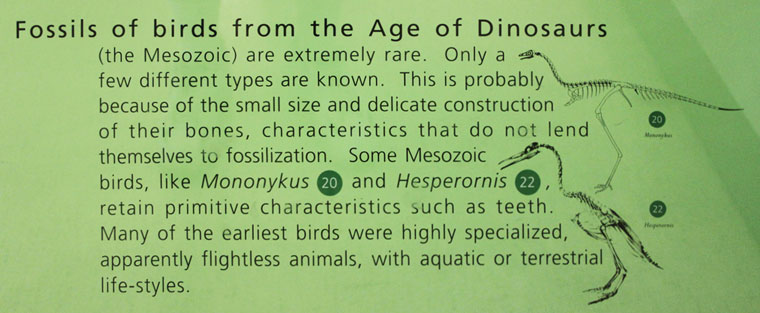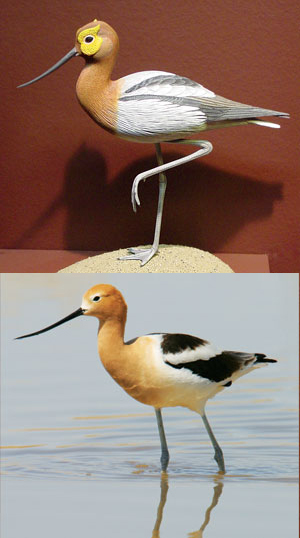Modern birds found with dinosaurs
Are museums misleading the public?

The theory of evolution states that all living creatures arose from a single cell by natural processes over eons of time, and God had nothing to do with this process. According to the theory each animal arose from a different kind of animal over ‘millions of years’. E.g. most evolutionists assert that modern birds evolved from dinosaurs. Finding fossils of modern birds with those of dinosaurs, not just above them, contradicts this idea.
Dr Carl Werner’s book and DVD, Living Fossils, reveals that fossil researchers have found many modern bird remains with dinosaurs, yet museums do not display these fossils, thus keeping this information from the public. By keeping this information hidden, children and adults are indoctrinated with the false idea that animals changed over time (since the time of the dinosaurs), and that evolution is true.
In order to test evolution, Dr Werner visited 60 natural history museums and ten dinosaur dig sites in seven different countries. When he asked paleontologists if they had any personal knowledge of modern birds found with dinosaurs, he was in for quite a surprise.
“I interviewed a scientist at the Museum of Paleontology at Berkeley who discussed a parrot fossil they had found in Cretaceous layers (‘dinosaur rock’). But the parrot fossil was not on display in the museum.”
With each interview, more modern birds that had been found with dinosaurs were added to his list, including: parrots, penguins, owls, sandpipers, albatross, flamingos, loons, ducks, cormorants and avocets. Carl assembled this list from interviews he did with various paleontologists, as well as from articles by evolutionist scientists and a textbook (the details of the sources can be found in Living Fossils).
It was not long before Dr. Werner noted an important discrepancy: museums were not displaying what the scientists were revealing in their one-on-one interviews. In fact, the natural history museums contradicted reality and were suggesting the opposite. Of the 60 museums he visited, he did not see one single fossil of a modern bird that had been found in a dinosaur rock layer and only one museum out of 60 displayed a modern bird model with a dinosaur: the Milwaukee Museum. In an out-of-the-way corner, the museum had a reconstructed avocet that had been found at Hell Creek (Montana) dinosaur dig site (see photo of avocet reconstruction below)—this is clearly an avocet.

Sign at the American Museum of Natural History, 2011. Contrary to the sign, Dr Werner discovered that many types of birds have been found with dinosaurs including ducks, loons, flamingos, albatross, owls, penguins, sandpipers, parrots, cormorants, avocets, as well as extinct birds such as Archaeopteryx and Hesperornis. While these extinct birds did have teeth, many other modern types of birds without teeth have been found. By leaving this fact out, the museum display misleads the public.
Dr Werner: “Museums do not show you these modern bird fossils nor do they put modern birds fleshed out with feathers in their dinosaur dioramas. This is wrong. Essentially, every time you see a T. rex or a Triceratops in a museum display, you should also see ducks, loons, flamingos or some of these other modern birds that have been found in the same rock layers as these dinosaurs, but this is not the case. I have never seen a duck with a dinosaur at a natural history museum, have you? An owl? A parrot?”

“Not only do they not display birds, but the prestigious American Museum of Natural History suggests the opposite in their dinosaur-to-bird placard. This display is extremely misleading and again does not mention modern birds with dinosaurs.” (See sign above)
Are the museum displays just out of date, or are they purposely withholding information? Two years after the release of Dr Werner’s book, the Carnegie Museum, the Smithsonian Museum and the American Museum of Natural History have still not corrected these discrepancies.
From Dr Werner’s global investigations, this is a worldwide phenomenon with the museums; only one museum gave any hint that modern birds have been found with dinosaurs.
It should be noted that modern birds were not found in all dinosaur layers, only Cretaceous layers (not in Jurassic or Triassic rocks). Evolutionist paleontologist Dr Bill Clemens told Carl that the Cretaceous bird fossils were found when they went looking for modern animals in the Cretaceous layers to provide evidence that the asteroid impact hypothesis was wrong1 (this is the idea that an asteroid impact wiped out the dinosaurs ‘at the end of the Cretaceous’). The researchers were trying to establish continuity between the fossils in the rocks above the Cretaceous with those in the Cretaceous; so they were looking for modern creatures. Who knows what they would find if they looked hard in the other layers?
On CMI’s documentary, Darwin—the Voyage that Shook the World, Professor Phil Currie, palaeontologist at the University of Alberta, Canada, spoke about how a researcher’s ‘search image’ can affect what is discovered. “In spite of the fact that you think you have an open mind, very often your perceptions of what things should be, or your search image, or your cultural beliefs in some cases, will actually be working on your mind so that your eyes are open but they are not really open; they are missing something that could take you in an entirely new direction.”
When researchers are looking for dinosaurs they tend to not even notice the remains of other creatures and plants. And when they are found, they tend to be put aside as uninteresting. Finding a new ‘exotic’ dinosaur is much more exciting and publicity-worthy than finding a bird or a mammal that everyone is familiar with. And of course funding agencies are after exciting finds of a lost world, not ‘boring’ fossils of modern creatures that also subtly suggest that animals did not evolve.
In spite of all these factors, more and more modern animals and plants are being found in rocks where they should not be, according to the evolutionary view. There are so many examples (such as those discussed in Living Fossils), that it amounts to a strong confirmation that animals did not change significantly over time, that God made things to reproduce ‘after their kind’; providing a powerful challenge to the evolutionary story.
Related Media
Dr William Clemens, UC Berkeley, on modern birds being found in Cretaceous rock. (Clip from Living Fossils DVD)
References and notes
- There is ample evidence against the impact theory of extinction—see for example creation.com/iridium. Return to text.





Readers’ comments
Comments are automatically closed 14 days after publication.